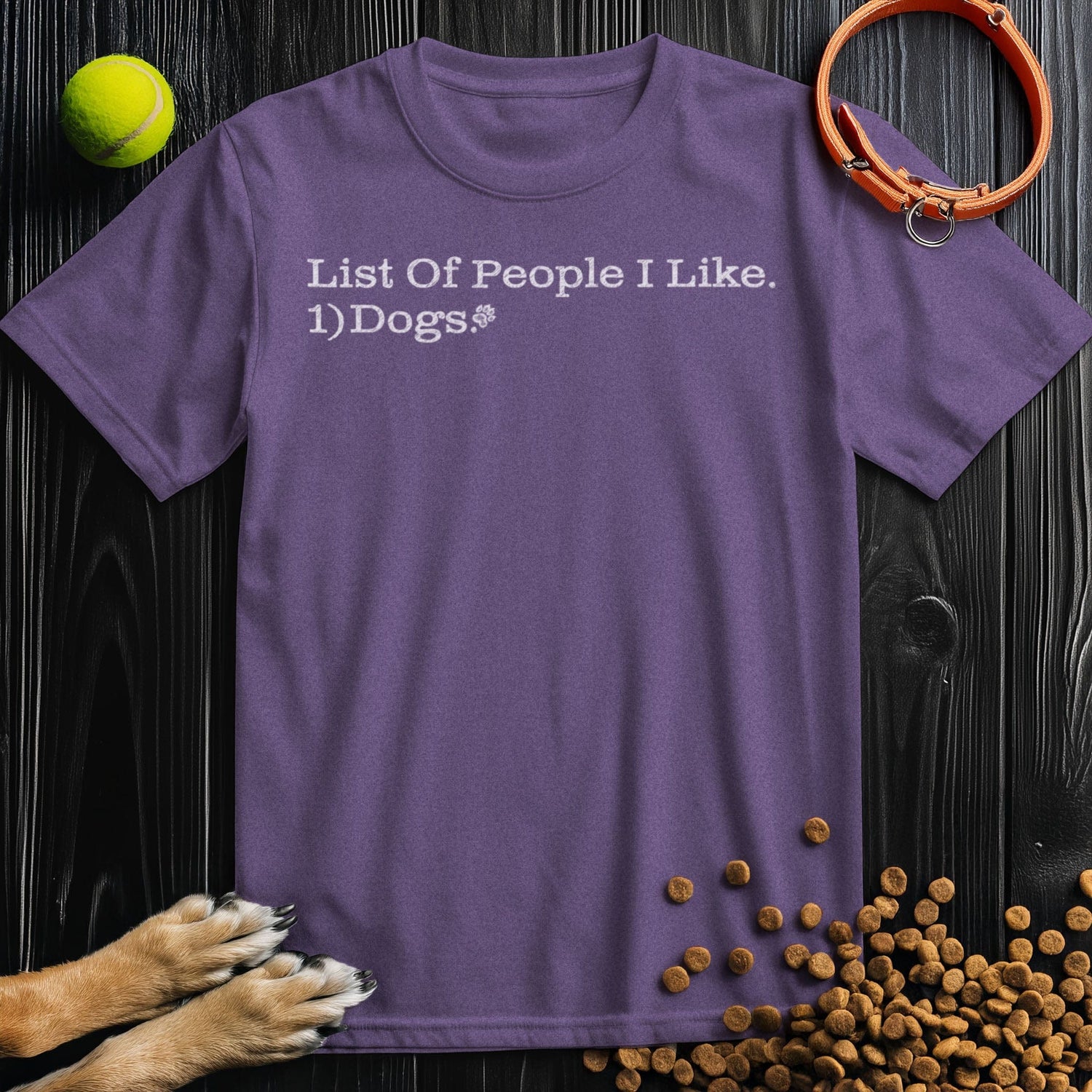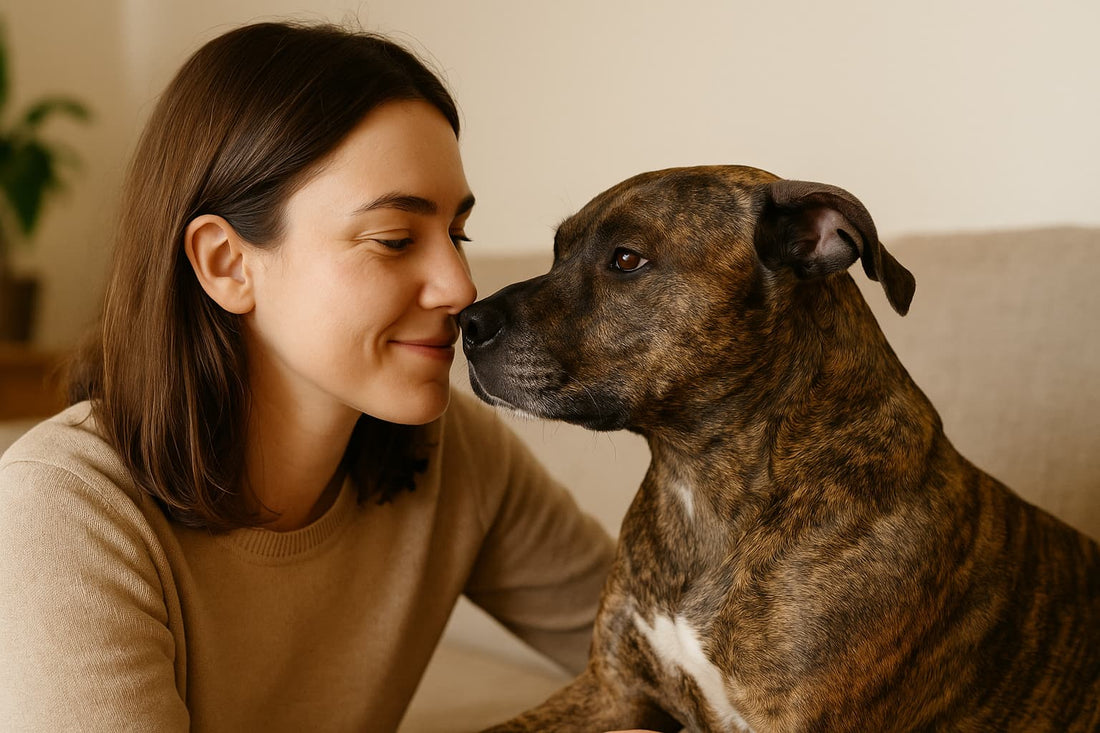Every dog owner likes to think their pup loves them. But is it really love, or just a dog looking for the next treat? Science says it’s love—and there’s proof. Researchers have studied everything from brain activity to heart rates and found that dogs can and do form deep bonds with their people.
Here’s what that looks like.
1. That Long, Soft Gaze
When your dog locks eyes with you in a calm moment, it’s not a staring contest. Researchers in Japan found that when dogs and owners look at each other, both release oxytocin—the same hormone that helps parents bond with babies. The longer the gaze, the higher the oxytocin.
Rhea, my seven-year-old blue-nose brindle American Staffordshire Terrier, does this after a walk. She’ll just sit there and look at me, no wag, no whining. It feels like she’s saying, “We’re good.”
2. The Tail Tells All
Not all tail wags mean the same thing. A study out of Italy found that dogs wag more to the right when they’re happy and more to the left when they’re uneasy.
If your dog sees you and the wag swings to the right with a loose body—yeah, that’s love. Rhea does a full wiggle, from nose to tail, the second she hears my keys in the lock.
3. Your Smell is Their Comfort
Dogs live through their noses. Gregory Berns, a neuroscientist, scanned dogs’ brains and found that the reward center lit up most when they smelled their owner—even more than when they smelled food.
If you’ve ever left an unwashed sweatshirt out when you’re gone, you’ve given your dog a comfort blanket.
4. Your Heartbeats Sync
There’s a thing called the “secure base effect” where bonded dogs and owners calm each other down. A study measured heart rates before and after reunions. Both dog and human heart rates dropped when they were back together. That’s not coincidence—it’s connection.
5. You Over Food
Yes, some dogs would choose a slice of ham over anyone. But not all. In one study, many dogs picked praise and pets over food. Brain scans showed the reward areas lit up for their owner’s voice just as much as for a snack. That’s a big deal.
6. Staying Close
Leaning, sitting beside you, sleeping near you—it’s more than just comfort. Physical closeness raises oxytocin in both of you.
My dog Rhea is a leaner. She’ll plant herself against my leg with her full weight like she’s trying to anchor herself there.
7. Gifts of Toys
When a dog brings you a toy, sometimes it’s an invite to play. Other times, it’s a trust move. They’re sharing something they value with you. That’s pack behavior.
8. Shadow Mode
If your dog follows you from room to room, they’re not being clingy for no reason. It’s instinct to stay close to the most important member of their “pack.” In the wild, separation can mean danger. At home, it’s just love.
9. Matching Your Mood
Dogs notice our emotions and often adjust to them. They’ll come closer when you’re sad, relax when you’re calm, or match your energy outside. It’s one of the reasons they’re so good for mental health.
10. The Reunion Scene
Ever seen a dog go into a happy frenzy when their person comes home? Spinning, barking, tail wagging so hard their whole body shakes. Researchers found that oxytocin can even make some dogs tear up during these moments.
11. The Play Invite
A bow, a paw tap, a goofy bounce—those are play invitations. And dogs usually save them for the people they like most. Play strengthens bonds and keeps the relationship positive.
12. Stepping Between You and Trouble
Sometimes love looks like protection. A dog that positions itself between you and a stranger or moves closer when you’re upset is showing they’ve got your back.
13. Sleeping Where You Sleep
In the wild, animals sleep close to those they trust. When your dog chooses to sleep in your bed or even just in your room, it’s their way of saying you’re part of their inner circle.
FAQ
Do all dogs show these signs?
Nope. Some are cuddlers, some aren’t. Breed, personality, and life experience all play a role.
Can a dog love more than one person?
Yes. But they often have a favorite—the person they turn to first for comfort.
Can training change how they show love?
Definitely. Positive training builds trust, which makes these behaviors more common. Harsh methods can shut them down.
Is it just about food?
Not for every dog. Many will still choose you even when snacks are on the table.
How long does bonding take?
Depends. Some dogs bond fast, others need months. Consistency is the key.
Can they “fall out of love”?
Not in the human sense. But they can lose trust. With patience, you can rebuild it.
Conclusion
Dogs may not write love notes or say the words, but they’ve got their own ways of telling us how they feel. A certain look, a tail wag, a toy dropped at your feet—it all adds up.
Living with Rhea has made that clear for me. The lean against my leg, the way she watches my face, the pure joy in her reunion wiggle—none of it feels random. It’s proof of a bond that’s real, deep, and mutual.
If you start paying attention to these little signals, you’ll see them more often. And the more you give back—time, care, patience—the more they’ll show you.
Sources:
- https://www.science.org/doi/10.1126/science.1261022
- https://www.akc.org/expert-advice/lifestyle/can-our-dogs-really-love-us/


